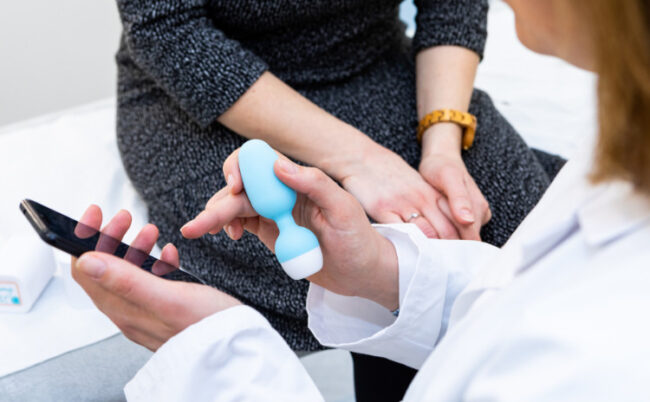You wish to carry out sessions of perineal rehabilitation with a physiotherapist but you don't know what to expect? We explain everything to you!
The perineal assessment during the first rehabilitation session
The aim of this session is to take stock of theoverall health of your perineum. With the help of a oral questionnaire to identify your disorders and a manual review, the physiotherapist to agree on the most suitable method for your perineal rehabilitation.

A questionnaire to target pelvic disorders
During your first session with the physiotherapist, you will be asked several questions about your state of health and on the presence or absence of certain disorders :
- urinary or anal incontinence
- vaginal flatulence
- feelings of heaviness
- pain during intercourse…

A manual exam to examine the pelvic floor
At the start of rehabilitation, the physiotherapist will then carry out a manual review of your perineum to best adapt its care. This manual testing allowsassess the muscular condition of your perineum.
The physiotherapist will also ask you to carry out different types of contraction with your perineum. He will thus be able to judge his tone and its fragility as well as the quality of contraction performed.
The purpose of this exam is to teach you how to perform a correct perineal contraction (without engaging the abs, thighs or glutes) and identify your perineal weaknesses. This allows the physiotherapist to target treatment and adapt the rehabilitation method proposed subsequently.

How does a perineal physiotherapy session take place?
Once the perineal assessment has been carried out, the physiotherapist has a overview of your condition and can therefore offer you the perineal rehabilitation method the most suitable for you.
In general, the techniques most used in physiotherapy practices are biofeedback and theperineal electrostimulation.
How does a biofeedback session take place?
The technique of biofeedback is based on the realization of voluntary perineal contractions by the patient. With this method, the patient becomes aware of the work carried out during his perineal rehabilitation.
Concretely, a vaginal probe (or anal) will detect perineal contractions carried out by the patient. This information is then transmitted to a screen where it is possible to visualize contractions in real time.
During a biofeedback rehabilitation session, the patient will have to follow contraction instructions displayed on a screen and will see in real time whether she is doing the job correctly or not.

With this method, the patient will be able to work different types of contraction according to the program used by the physiotherapist: repeated contractions, to be maintained over time, to be carried out quickly…
Biofeedback allows active rehabilitation since the patient has a real awareness of the contraction of his perineum and its good execution.
This learning also promotes the implementation of reflex contractions to protect your pelvic floor on a daily basis. At the end of rehabilitation, the sessions can also take place standing or in stressful situation such as when coughing and carrying a load.
How does an electrostimulation session take place?
The principle ofelectrostimulation lies in the application of a fluent electric For stimulate the pelvic muscles. The physiotherapist programs a series of electrical stimulations which are sent locally at the level of the perineum (using attached electrodes or a vaginal or anal probe).
In this method, the muscle contraction is called “ reflex“. It is therefore not the patient who performs the contraction action, it is a passive contraction.
Perineal electrostimulation sessions allow start rehabilitation when the patient does not have good knowledge of her perineum and is not well aware of her contractions. Electrostimulation is useful for learning to better locate his perineum.

How does a manual rehabilitation session take place?
In case your perineum has suffered a recent trauma, as in the case of childbirth for example, it is possible that the physiotherapist will suggest that you start your rehabilitation by manual sessions.

In case of tears or episiotomy, the aim of the sessions initially will be above all to work on relaxation of the perineum or massage the scar.
Role of the physiotherapist in perineal therapy
During perineal rehabilitation sessions, the physiotherapist has a essential role. He will be able to guide and advise you throughout your sessions on several aspects.
- Muscle work : learning the correct contraction of the pelvic muscles
- Tension relief if pain is present
- Behavioral rehabilitation And posture adjustment, especially in cases of disorders such as incontinence
- Maintenance tips to have a good position and not damage your perineum
- Accompaniement during sports practice

The physiotherapist will also be able to give you lots of information concerning the rehabilitation of the perineum overall and respond to all your questions about the perineum.
Besides, if you are looking for a physiotherapist specializing in perineal rehabilitation near you, we explain how to quickly identify an expert.
Continue your perineal rehabilitation at home
Once your rehabilitation sessions are completed, the physiotherapist will recommend that you continue muscle exercises at home. Indeed, these exercises are essential for maintain profits sessions carried out in office.

They will allow you to maintain a toned perineum andavoid the appearance (or reappearance) of inconveniences linked to this area.
To do this, there are numerous devices to achieve these home exercises like for example the Emy perineal probe.
Emy, a probe for perineal rehabilitation at home
The Emy biofeedback medical device is composed of a vaginal probe and a mobile app. Thus, it allows visualize your perineal contractions live on his smartphone.
In the application, we find mini games based on the same medical protocols as those used in the office by physiotherapists.
This wireless probe therefore has many advantages if you are looking for a solution for continue your exercises at home.

Learn more about the Emy probe
Personalization of home exercises by the physiotherapist
One of the main advantages of the Emy probe is the personalization of your exercises by the physiotherapist in charge of your perineal rehabilitation.
In fact, he will be able to set up training sessions for you.tailor-made exercises to carry out at home with the biofeedback probe. This will allow you to perform a targeted work adapted to your needs directly at home.

Your physiotherapist can also personalize the exercise protocol to make at home. Depending on your weaknesses, he will favor one or the other type of contraction to work on :
- long to maintain over time
- quick to do as quickly as possible
- repeated in different time intervals
Level of difficulty adapted to each patient
When the physiotherapist chooses the exercises for your program, he will be able to choose different levels of difficulty for your exercises. The level of difficulty of your training program will therefore be adapted to your needs.
In addition, the Emy application has intelligent algorithms. Even if you do not perform an exercise session done by your physiotherapist, the exercises that will be offered to you will adapt to both your tone of the day and to your previous workout results to allow you to always progress.
Learn more about the Emy probe
Work in different positions
The Emy probe allows you to do perineal exercises in different positions :
- semi-recumbent or supine
- sitting
- standing

At the start of each session, the probe will be calibrated to adapt the level of exercises to the tone of your perineum.
This is one of the reasons, in addition to its adapted form, for which the Emy probe is particularly recommended for all perineums, even the most relaxed.
Use of the Emy probe in the physiotherapist's office
Another particularity of the Emy device is that it can be connect directly on the machines used in physiotherapy practices.
Indeed, the Emy probe is compatible with certain software available from physiotherapists. This makes it possible to make use both in the office with the physiotherapist, then at home to complete his rehabilitation.

It is also an excellent way to work at home between sessions with the physiotherapist.
The benefits of this work between office sessions are twofold. The patient works purposefully at home and progress faster in his rehabilitation.
The effects are therefore felt faster on the pelvic floor. This allows the physiotherapist during in-office sessions to go even further in personalization of the exercises offered.
Learn more about the Emy probe
A physiotherapist’s opinion on the Emy probe
Martine Cornillet-Bernard, former president of theHASFRePP (French Association of Rehabilitation in Pelvi-perineology) carried out perineal rehabilitation his hobby horse.
It therefore seemed legitimate to us to ask him for his opinion on the Emy perineal probe.
« What especially interested me with the Emy probe was above all the relationship between the Fizimed company and the therapists. That is to say, they are listening for the transformation of their probe. They are attentive to the feedback we can provide. Whether in terms of signal capture or the programs that are offered. I think that’s really what’s important. Indeed, the therapist must observe the reliability of the programs that are offered. The exercises are not offered haphazardly. There are principles of muscle strengthening. They must be applied and I think it is this exchange that is important. »
Martine Cornillet-Bernard, physiotherapist






